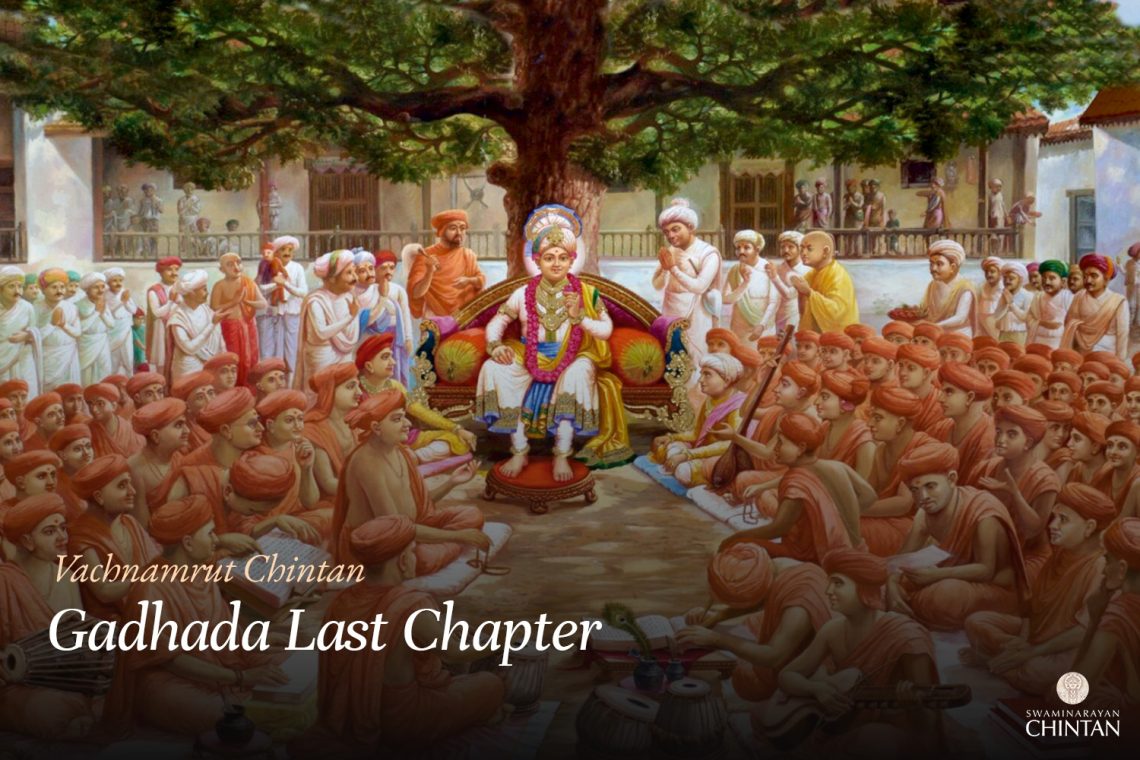Central Insights:
- Performing bhakti (devotion) while staying aligned with one’s inherent qualities (ang).
Key Points:
- The form of bhakti that helps one’s mind focus on Bhagwan and prevents distractions from Panch Vishay (the five sensory pleasures) is considered one’s ang.
- By practicing bhakti that aligns with one’s ang, one experiences immense spiritual progress.
Explanation:
This Vachanamrut is known as The Proper Bandage. Maharaj gives an analogy: just as a brave warrior, wounded in battle, cannot rest or sleep until his bandages are properly adjusted, a mumukshu (one desiring liberation) or sadhak jiva (spiritual aspirant) experiences a similar state on the path to Bhagwan. When the warrior’s bandages are adjusted, his pain subsides, and he can rest. Similarly, a soul wounded by the Panch Vishay or internal enemies like kama (lust) and krodha (anger) must find relief through the appropriate type of bhakti.
When a mumukshu or aspirant attempts to progress in Bhagwan’s path, past impressions of Panch Vishay, indulgences, and internal enemies resurface. This is akin to the way a warrior, when lying down, becomes acutely aware of his wounds. For the aspirant, these memories, habits, and proficiency in such indulgences become vivid when engaging in Mansi Pooja (mental worship), meditation, or chanting. Consequently, the aspirant feels grief, frustration, and mental anguish, much like a wounded soldier enduring pain.
To ease this pain, Maharaj suggests focusing on the form of bhakti from the Navadha Bhakti (nine forms of devotion) that best suits the aspirant, enabling them to focus solely on Bhagwan. When an aspirant discovers the bhakti that brings peace and concentration, it is said that their “bandage is adjusted.” This specific bhakti becomes their ang. Practicing this form of devotion allows the aspirant to immerse their mind entirely in Bhagwan, gaining courage and enthusiasm on the path to liberation.
If the aspirant fails to identify their ang and adjust their approach, their sorrow and feelings of defeat will persist, just as a warrior’s pain persists until his bandage is fixed. Thus, it is crucial for a devotee to identify their specific form of bhakti.
The form of bhakti that enables one to transcend body- consciousness and rise above the defeats caused by Panch Vishay or internal enemies is considered one’s ang. Once identified, this form of bhakti should take precedence, while others can be secondary and supportive. This allows the soul to progress significantly, cutting the bonds of Panch Vishay and internal enemies and attaining liberation in due course.
In summary, the bhakti that effectively anchors the mind in Bhagwan and prevents thoughts of worldly pleasures or internal enemies is one’s ang. Whether it is one of the Navadha Bhakti, service, satsang, or any other spiritual activity, if it suits one’s disposition and provides peace, it should be prioritized. By focusing on such a practice, the aspirant gains the strength to overcome internal enemies, renounce worldly desires, and become deeply connected with Bhagwan.
Glossary
| Bhakti – Devotion Loving and selfless worship of God. |
| Ang – Inherent quality A form of devotion that aligns with an aspirant’s natural disposition and helps them focus on Bhagwan. |
| Panch Vishay – Five sensory objects The worldly temptations related to sight, sound, smell, taste, and touch. |
| Mumukshu – Seeker of liberation (Moksha) |
| Sadhak Jeev – Spiritual aspirant |
| Mansi Pooja – Mental worship A form of devotion performed mentally, imagining oneself serving or worshiping Bhagwan. |
| Kama – Lust |
| Krodha – Anger |
| Navadha Bhakti – Nine forms of |
| Dhyana – Meditation |
| Bhagwan’s Greatness – The supreme and unparalleled attributes of Bhagwan |
| Ishta-dev – Chosen deity |
| Haribhakta – Devotee of God devotion The different ways of expressing devotion to Bhagwan, such as Kirtan, Katha, and Mansi Puja. |
| Bandage Analogy – Symbol for aligning practices A metaphor for identifying and practicing the right form of devotion that provides relief from spiritual struggles. |
| Internal Enemies – Lust, anger, greed, and other vices Negative tendencies within a person that obstruct spiritual growth. |
| Moksha – Liberation |
| Satsang – Holy fellowship |

